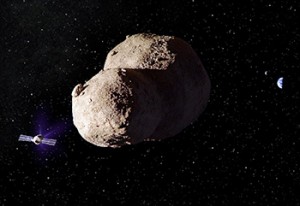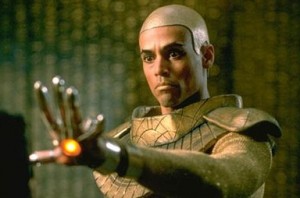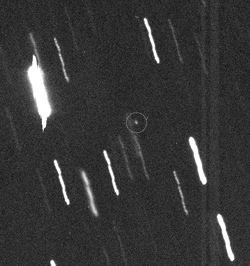 What is it with all the bad media reports of cosmic doomsdays? Betelgeuse last week, giant spaceships before that, and now Apophis. Sigh.
What is it with all the bad media reports of cosmic doomsdays? Betelgeuse last week, giant spaceships before that, and now Apophis. Sigh.
Here’s the scoop: I was tipped off about this by Jesse Emspak, who writes for the International Business Time (and who wrote a great article about the real opportunities represented by Apophis), and who told me about a Russian news site which, a few days ago, posted an article about the asteroid Apophis with the very menacing title, “Russian astronomers predict Apophis-Earth collision in 2036”.
Sounds scary, right? One problem: it’s 100% utter crap.
Rock will roll on by
 |
| This guy won’t help. |
Let me be very, very clear: the odds of this happening are incredibly low, something like one in a 135,000. I fret about asteroid impacts, as you might imagine, but this one doesn’t worry me at all. The odds are so low I worry more about Snooki getting her own three-movie contract.
The reason the impact odds are so low, but not zero, is that we don’t precisely know Apophis’s orbit. There is a tiny region of space above the Earth called the keyhole, and Apophis has to pass right through it to have its orbit modified enough to hit us on the next path. We can’t know for sure if the rock will pass through the keyhole or not in 2029, but we can apply statistics and calculate that minuscule 0.0007% chance. And maybe it’s better to think of it as a 99.9993% chance it’ll miss.
Feel better?
Apophisalypse
OK, so what’s with that Russian news article? Besides the breathless – and totally wrong – headline, here’s the first line:
Russian astronomers have predicted that asteroid Apophis may strike Earth on April 13, 2036.
Bzzzzzt. While technically correct, this gives the strong impression that the odds of impact are high. That’s irresponsible journalism at best. Yet things quickly get worse:
“Apophis will approach Earth at a distance of 37,000-38,000 kilometers on April 13, 2029. Its likely collision with Earth may occur on April 13, 2036,” Professor Leonid Sokolov of the St. Petersburg State University said.
Aiieeee! The collision is “likely”? Aiiieee!
Except for the small fact that, like I said, it’s not. In fact, even “unlikely” is way too strong a word for it. I’d bet my life savings against an impact. But the article continues:
The scientist said, however, the chance of a collision in 2036 was extremely slim saying that the asteroid would likely disintegrate into smaller parts and smaller collisions with Earth could occur in the following years.
Well, for Pete(resburg)’s sake. Which is it? Likely, or extremely slim? Sigh.
That last bit is interesting, though. The asteroid would disintegrate? What?
Now, that’s not a totally crazy idea. Some asteroids are not actually solid; they’re more like flying piles of rubble held together by their own gravity. We’ve actually seen asteroids like this, so we know they exist. If they’re big enough, and pass close enough to Earth, our gravity could pull them apart. The thing is, Apophis is only about 250 meters across, which is on the small side for this happen. So why would the article say it might fly apart?
I decided I needed to go to the source.
Leonid’s meteor
 I did a web search on the astronomer quoted in the article, Leonid Sokolov. I had never heard of him, but of course there are thousands of astronomers on the planet. A little digging on the ‘net turned him up, and as it happens he is in fact a Russian astronomer and a member of the International Astronomical Union. I found his email address, and sent him a carefully-worded email asking him if he felt the article represented his view fairly.
I did a web search on the astronomer quoted in the article, Leonid Sokolov. I had never heard of him, but of course there are thousands of astronomers on the planet. A little digging on the ‘net turned him up, and as it happens he is in fact a Russian astronomer and a member of the International Astronomical Union. I found his email address, and sent him a carefully-worded email asking him if he felt the article represented his view fairly.
I got an email back later that night that was pretty clear:
This is “bad mass communication”, journalist misunderstanding, not “bad astronomy” […] The probability of Apophis collision in 2036 is VERY-VERY SMALL, but not zero, the probability of Apophis collision after 2036 is VERY-VERY-VERY SMALL, but not zero.
Aha! As I suspected, we have a case here of a journalist grossly misrepresenting what an astronomer said. I had at first wondered if maybe there was a mistranslation to English, but what Dr. Sokolov is saying is that the reporter really just screwed this up. Massively. And what Sokolov said in his email to me is essentially correct. The odds are very small but not zero, and the odds get even lower after 2036.
But what about that weird bit about Apophis disintegrating and pummeling us like a shotgun? Sokolov told me:
In my talk I have spoken about SCATTERING OF POSSIBLE TRAJECTORIES of Apophis after approach in 2029 and possible approach in 2036, NOT DISRUPTION of asteroid!
Ah, I see. The word “scattering” is where things went awry.
When we observe an asteroid, we cannot get its precise position in space. There’s always some uncertainty caused by various factors like measurement errors inherent in the images, atmospheric distortions blurring out the image of the asteroid, the effects of sunlight radiation pressure on the orbit, and lots of other things. So we get an orbit that’s not exact, and projecting that into the future makes it even worse. Sometimes that means we have no idea where the rock will be in a decade or two. However, in the case of Apophis, we do have a good enough orbit to nail down its position in April 2029 to a few kilometers, accurately enough to know it will miss, but not accurately enough to know if it’ll pass through the keyhole. The most likely path it will take is outside the keyhole, but the uncertainty in the orbit just barely overlaps the keyhole. That’s why we can say the odds are so low, but not exactly zero.
So after that pass in 2029, we don’t know its exact orbit. Think of it this way: imagine three rocks all lined up next to each other approaching the Earth. One is closest to us, one in the middle, and one farther away. The Earth’s gravity is slightly different on each one, so after the pass their orbits are all different. They will move apart over time, the Earth having – aha! – scattered them.
That’s what Sokolov meant. He calculated the possible orbits of Apophis after it passes us, and sees them diverging. So it was the potential paths of Apophis that get scattered, not the rock itself!
So the reporter messed that part up too.
This too shall pass
This kind of stuff really ticks me off, as you might have noticed. Scaring people is not something I take lightly, whether it’s frauds riling up parents about vaccines and autism, or making up stories about nearby supernovae and 2012. You may just blow it off and think that if people don’t educate themselves on science, well, caveat emptor. But I think that’s the wrong attitude; the fact of the matter is there’s just too much misinformation out there to expect people to educate themselves on everything. People have lives, they’re busy, they have other concerns. If they hear something like this and lack the critical thinking or educational background to parse the story correctly, then we are all to blame. It’s up to all of us to get out there and teach people how to separate reality from nonsense.
And I’m not a fool, I know that that’s impossible to do for everyone. But we can minimize it. And maybe, if we can get to enough folks, we’ll reach a critical mass – a herd immunity, if you will – where nonsense will find it can’t get a toehold. Enough people will know better that such antiscience, antireality thinking may become an endangered species.
And you know what? That’s one mass extinction I can live with.
Image credit: Dan Durda; UH/IA
Related posts:
- Apophis danger downgraded
- In Russia, Apophis impacts YOU
- No, a 13 year old boy did boy correct NASA
- We’re all doomed! Oh wait, no we’re not